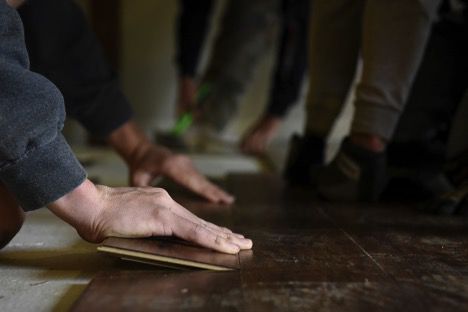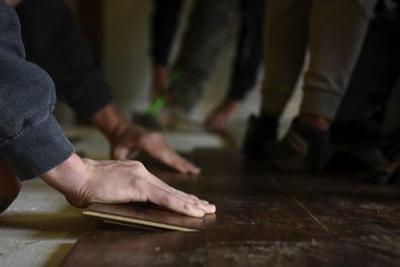Laminate flooring wasn’t a big deal back in the day. However, with increased demand for economic flooring, this type of flooring is taking many homes by storm. Nevertheless, with all the economics and quality of the flooring style, the question that comes to mind is, which type of flooring is best-suited for my home?
In this guide, we’ll take a look at the different types and characteristics of laminate flooring.
Laminate Texture
The aesthetics of laminate floors is unbeatable because of its resemblance to the hardwood. However, to get the hardwood look, you need a laminate floor of a certain texture. Below are some of the various textures you can choose from:
- Matte Finish. This type of look is similar to hardwood floors because of its wood-like texture. In fact, it’s one of the most popular types.
- Natural Wood Finish. As the name suggests, this type feels like the natural wood and is more popular with homeowners looking for a distinct type of texture.
- Oiled Wood Finish. If you’ve come across natural, untreated hardwood floors, then the oiled wood is not far from it. This type of laminate flooring gives the floor a natural and polished look thanks to the natural oils.
- Oxide, Surface Finish. This is common for chic and modern interiors to give the area a shiny look with the metallic finish.
- Piano/High Gloss Finish. This is for the high-end customers looking for some elegance in their interiors.
- Stone/Slate Finish. Just how a slate or stone looks like, this type of flooring appears as it is.
Laminate Thickness
The laminate floors are measured in millimeters (mm) and is also a key feature in varying laminate floor types. Some of the most common thicknesses include the 12mm, 10mm, 8mm and 7mm.
Most of the time, the subfloor stability will determine the laminate flooring thickness. The more stable the former, the thinner the flooring you’ll require. For homes and offices, thicker laminate flooring is best suited.

For doors, appliances, cabinets, and built-ins, the guiding factor in installing the laminate floors will be the amount of space between the objects and the subfloor.
Laminate Floor Width
The width of the laminate floor can change the entire look of your room. Depending on your room, you can choose from the following widths:
- Multi-Width. You can use this width for barn-wood or reclaimed looks to give your room a unique dimension.
- More than 6 inches. This type of laminate floors gives the room a wide plank look or tile effect laminate floors. However, this width best fits large room spaces.
- 5 to 6 inches. This width is the most common in the market and fits all types of room spaces.
- 3 to 4 inches: these are thin boards often used to make small rooms appear larger.
Laminate Floors by Edge Type
The edges simply describe how every laminate plank is cut. The edges define how the planks fit together, whether smoothly or has a distinct edge. Take a look at some of the different edge-types:
- Painted Bevel. The edges of the plank are painted in the grooves to give it a more distinct look.
- Rolled Bevel. The color and design of the floor go past the edge or "rolls over" to give the plank a continuous look.
- V-Groove or Deep Bevel. This unique type gives the edges a V look making the room more pronounced with unending Vs.
- Micro-Bevel. Many homes use this type of laminate flooring. In this type, the corners are rounded using fine micro-bevel.
- Square Edge. The edges here are cut at a 90-degree angle to connect with the next plank in a seamless manner.
Laminate Floor by Plank Style
There are 3 main laminate flooring styles:
- 1-strip plank. This style brings out the exact look of hardwood floors. This style comes with long planks with beveled edges is often the highest quality.
- 2-Strip Plank. With this style, you get the natural hardwood look.
- 3-Strip Plank. This design gives the floor a 3-strip look on one plank.
No matter what your design vision, it will be easy to get it with laminate, and you can be ensured that it will look authentic, too. The various styles contain rustic, weathered, hand-scraped and reclaimed outlooks. Stone looks more like range from Spanish-style pavers to slate tile. And the innovative design technology even allows creating unique flooring inspired by unexpected materials, blending wood, metal and concrete visuals.





(0) comments
We welcome your comments
Log In
Post a comment as Guest
Keep it Clean. Please avoid obscene, vulgar, lewd, racist or sexually-oriented language.
PLEASE TURN OFF YOUR CAPS LOCK.
Don't Threaten. Threats of harming another person will not be tolerated.
Be Truthful. Don't knowingly lie about anyone or anything.
Be Nice. No racism, sexism or any sort of -ism that is degrading to another person.
Be Proactive. Use the 'Report' link on each comment to let us know of abusive posts.
Share with Us. We'd love to hear eyewitness accounts, the history behind an article.